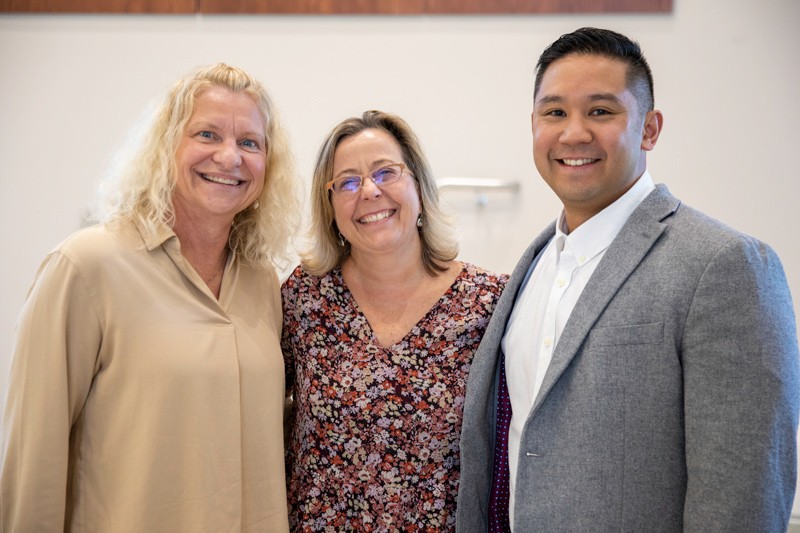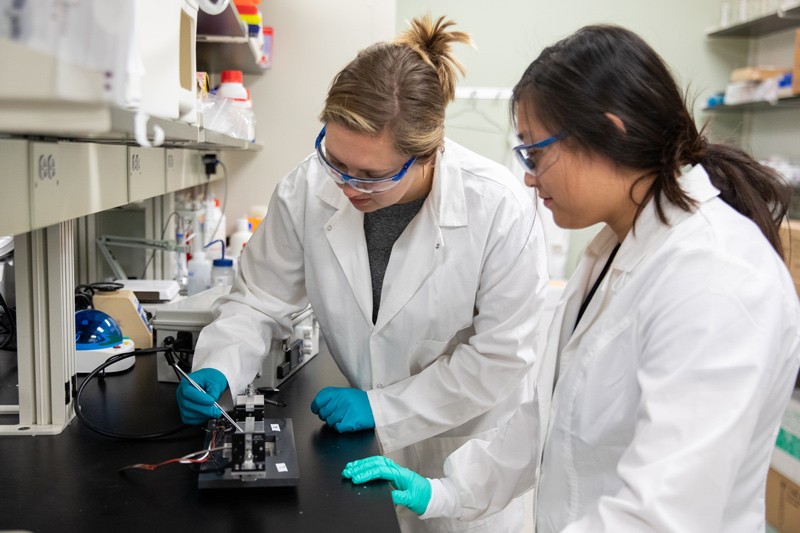NIH supports cross-disciplinary collaboration involving professors from three UD colleges
From age 3 through high school, Lily Lin was an award-winning gymnast, placing in state and regional championships.
“It’s such a high-impact sport. I suffered from a herniated disc and tendinopathy, and so I know the impact and how debilitating it can be,” she said.
Inspired by her own past injuries, the gymnast-turned-biomedical engineering doctoral student at the University of Delaware is now studying tendon overload. She’s part of an interdisciplinary team, led by primary investigator Dawn Elliott, Blue and Gold Distinguished Professor of Biomedical Engineering within the College of Engineering (COE). Elliott, along with co-investigators Karin Grävare Silbernagel, professor of physical therapy in the College of Health Sciences (CHS), and Justin Parreno, assistant professor of biology in the College of Arts and Sciences (CAS), have been awarded a nearly $2.4 million, five-year R01 Grant from the National Institutes of Health (NIH) to investigate multi-scale tendon damage and abnormal cellular responses in tendinopathy.
Elliott has been wanting to study the tendon for some time because musculoskeletal disorders are the leading cause of disabilities in the world. The tremendous impact of musculoskeletal disorders also motivated Elliott to build a team of UD leaders to launch the Delaware Center for Musculoskeletal Research, a National Institutes of Health-designated Center of Biomedical Research Excellence, established through an $11.8 million grant, that will build research capabilities in this area. The new tendon collaboration and grant showcase what promises to be a tremendous future for musculoskeletal research at the University.
“All of the musculoskeletal tissues are extraordinary materials that undergo tremendously large loads that last for decades,” Elliott said. “For me, tendons and the meniscus are fascinating from a mechanical, structural system, and musculoskeletal tissues are incredibly important because their proper function is essential to a normal life. Musculoskeletal injuries have a devastating impact on your quality of life, to the point where sometimes you can’t live on your own. To me, it’s a combination of a fascinating engineering problem and an important functional problem.”
One severely debilitating injury is an Achilles tendon rupture that happens, often in athletes, without warning.
“One day they jump, and their Achilles tendon ruptures, and it’s very painful, and has a long healing time,” Elliott said. “We don’t know how it happened or how it got to that point. We believe it’s related to overloading efforts like weightlifting or other high forces on the tissue.”
Silbernagel, who’s an expert in the Achilles tendon, often sees runners suffer from pain in their Achilles.
“They have morning stiffness,” Silbernagel said. “A lot of them might have started training for a marathon, and the weather has been bad, and they haven’t trained enough. They think they need to run more to get better, so they increase their running load without giving their body enough time to recover. The tendon, when it’s overused won’t function as well and won’t give you your energy back.”
She points out that scenario is overuse of the tendon over time. When a football or basketball player ruptures their Achilles tendon, often it’s due to a high load on the tendon for a short period of time.
“That’s an extreme overload injury, and the tendon simply can’t tolerate it,” Silbernagel said.

From left to right, Karin Grävare Silbernagel, professor of physical therapy; primary investigator Blue and Gold Distinguished Professor of Biomedical Engineering Dawn Elliott; and Justin Parreno, assistant professor of biology, have been awarded a $2.3 million grant from the NIH to study multi-scale tendon damage and abnormal cellular responses in tendinopathy.
Through an animal model, the researchers are looking to determine how overload leads to tendon disorders, damage to the tissue, and eventual tears.
Picture the human tendon like a large, stretchy rubber band made of collagen.
“Too much stretch is a bad thing, and the stretch on the collagen can lead to a breakdown of communication, so the cells can no longer interpret those mechanical signals from the tendon,” Parreno said. “If the cells can’t sense the load anymore, it leads to the degeneration of the tendon.”
On the same day they received notice of the NIH award, Parreno broke a tendon in his finger playing basketball.
“It’s like motivation,” he said with a laugh. “I guess I’m a case in point. I’ve always been interested in mechanical loading of your tissues when you exercise, and when you play sports and how your body responds to that.”
After overloading a key tendon, over the course of four months, investigators will study the degeneration or changes in its structure, mechanical properties, and the cellular response.
“Over time, we expect to see the structure of the tendon to become less organized and its mechanical properties will continually go down,” Elliott said.
If the trio can determine when the tendon degenerates or fractures, they can determine the cause and how to prevent these debilitating injuries. That has clinical implications that interest Silbernagel, who works with numerous professional teams to help players return to sport after Achilles tendon injuries.
“These injuries are costly,” Silbernagel said. “Athletes can take a year to recover, and some can never return to football, and it’s hard to know how to prevent these injuries because we don’t know when they’re going to happen. But if we start understanding the pathology, perhaps we can start thinking about science-based prevention. We currently do a one-size-fits-all for the tendinopathies and the ruptures. By understanding more, we can design better treatments for patients.”
Ellen Bloom, a Division I swimmer in college, suffered from that one-size-fits-all approach.
“I suffered from a lot of tendinopathy, and most of the treatments don’t work,” Bloom said. “I hope after the data collection period is through, we can really understand the underlying mechanisms of how these tendon overuse injuries happen.”
Bloom, who’s preparing to graduate from UD with her doctorate in biomedical engineering in December, did a lot of the work that made this grant attainable. She received an F31 Individual Fellowship from the NIH that made this possible.
“My thesis on tendon overuse injuries contains a lot of the pilot data for this grant,” Bloom said. “So, this grant does feel kind of like my little baby. But it’s also such a huge project, and I’m very proud of that.”
Bloom and Lin point to Elliott as the driving force behind their studies. Bloom called Elliott a supportive mentor as she watched her own transition from an undergraduate to becoming a colleague and contributor.
“Dawn gave me the confidence in myself as a scientist, but also the humility to acknowledge that I don’t know everything,” Bloom said. “She taught me to be open to making mistakes and sometimes that’s how you can have really exciting science.”
As Bloom prepares to defend her thesis, she’s leaving her work in the capable hands of Elliott, Parreno, Silbernagel and Lin.
“We’re just starting to get to a point in this collaboration, where we can start to ask new questions,” Bloom said. “I’m excited to see what they come up with after I leave because it’s a great group and so fun to see a collaboration where everyone is so invested and so interested to learn from one another.”
Beyond their intrigue in studying the tendon, all five researchers are equally excited about the interdisciplinary approach.
“We couldn’t do this project without the expertise from the College of Health Sciences and the College of Arts and Sciences,” Elliott said. “We all bring a unique skill set, and it’s impossible to do the work without the collaboration.”
The three faculty and their lab members meet monthly for a journal club to share their insights and expertise. Parreno finds tremendous value in interdisciplinary research.
“The students in my lab, they don’t all work on tendon research, and they feel it’s really eye-opening,” Parreno said. “We’re stuck in the minutia of the real molecular mechanisms of disease, whereas they’re focused on a clinical problem, and if there’s more of this cross-disciplinary collaboration, we can align our research better with a clinical problem.”
Lin added, “We talk about different articles from our respective fields. It’s cool seeing things from a pure biological standpoint and seeing how it translates clinically.”
Silbernagel called the interdisciplinary approach key to success.
“I think more people should listen to people with broader perspectives,” Silbernagel said. “I train all my students that we’re not in silos so they understand how all parts of research can help to inform each other to move ideas forward.”
Article by Amy Cherry | Photos by Ashley Barnas | November 14, 2022

